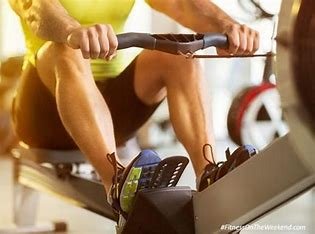Rowing is an exceptional full-body workout that combines both strength and cardiovascular conditioning. It effectively targets multiple muscle groups while providing an intense cardio session.

Impact on Muscles
- Upper Body:
- Back: The rowing motion activates the latissimus dorsi (lats), rhomboids, and trapezius muscles. This helps build a strong, defined back, improving posture and reducing the risk of back pain.
- Arms: Rowing engages both the biceps and triceps as you pull the oar or handle towards your torso. The repetitive motion helps build arm strength and endurance, leading to toned arms.
- Shoulders: The deltoids (shoulder muscles) are engaged during the pulling phase, helping to develop shoulder strength and stability.
- Core:
- Rowing requires a stable core for balance and effective transfer of power from the legs to the upper body. The movement works the abdominals, obliques, and lower back muscles, especially as you initiate the row and rotate during the pull phase.
- A strong core is essential for maintaining good posture, which reduces the risk of injury during rowing.
- Lower Body:
- Legs: Rowing is a lower-body dominant workout, with the majority of the power coming from the legs. The quadriceps, hamstrings, glutes, and calves are all heavily engaged as you push off the footboard with each stroke.
- The legs provide the initial drive, and the glutes are particularly activated during the push phase, contributing to improved lower body strength and muscle endurance.
Cardiovascular Conditioning
- Heart Health: Rowing is an excellent cardio exercise that elevates the heart rate, providing an aerobic workout that strengthens the heart and improves blood circulation.
- Endurance: Regular rowing improves cardiovascular endurance, helping the heart pump more efficiently and increasing overall stamina. It also increases VO2 max, which is a key indicator of cardiovascular fitness.
- Fat Burning: The intensity of rowing makes it an effective fat-burning exercise. It can help improve overall body composition by reducing body fat and increasing muscle mass.
Low Impact, High Reward
- Joint-Friendly: Rowing is a low-impact exercise, meaning it’s gentler on the joints compared to high-impact activities like running. The smooth, fluid motion reduces the risk of injury, making it a great option for people with joint concerns or those recovering from injuries.
- Full-Body Engagement: Unlike exercises that isolate certain muscle groups, rowing engages muscles across the entire body, making it an incredibly efficient way to get a full-body workout in a short amount of time.
Mental Health Benefits
- Stress Relief: The rhythmic motion of rowing, combined with the focus on technique, can be meditative and help reduce stress. The continuous movement also promotes the release of endorphins, improving mood and reducing anxiety.
- Focus and Mindfulness: Because rowing requires coordination and concentration, it helps improve mental focus and promotes a sense of mindfulness during the workout.
Posture and Flexibility
- Posture Improvement: Since rowing engages the core and the back muscles, it can help improve posture, especially for those who sit for long periods during the day.
- Flexibility: The rowing motion encourages flexibility in the shoulders and hips, helping to increase range of motion and reduce stiffness.
Rowing Technique:
To maximize the benefits of rowing and minimize the risk of injury, proper technique is crucial. The rowing stroke involves four main phases:
- Catch: This is where you begin each stroke. Your body should be leaned forward, with your arms extended and knees bent. Your back should be straight and your core engaged.
- Drive: This phase involves pushing with the legs while keeping your arms extended. The power of the stroke should come from your legs, not your arms.
- Finish: As you complete the stroke, your legs should be straight, and the handle should be pulled to your chest. Your back should be slightly reclined, and your core should be engaged.
- Recovery: This is the phase where you return to the catch position, relaxing your arms and allowing your knees to bend and your body to lean forward in preparation for the next stroke.
Rowing Machine Benefits
- Convenience: Rowing machines are available in most gyms and can be used indoors, making them accessible regardless of weather.
- Adjustable Intensity: Rowing machines offer adjustable resistance levels, allowing you to tailor the intensity of your workout to your fitness level.
- Efficiency: Rowing provides a high-calorie burn in a short amount of time, making it great for those looking to maximize their workout efficiency.
Overall Benefits of Rowing
- Full-body workout that targets the arms, back, core, and legs.
- Improves cardiovascular health and boosts endurance.
- Increases strength in key muscle groups, especially the core and legs.
- Low-impact exercise, reducing the risk of injury while still providing a challenging workout.
- Mental health benefits like stress reduction, improved mood, and mindfulness.
- Improves posture by strengthening the back and core.
Conclusion
Rowing is an effective and versatile workout that offers both strength and cardio benefits. It engages the entire body, making it an efficient way to improve muscle tone, cardiovascular health, and endurance, all while being easy on the joints. Whether you’re looking to improve overall fitness, build strength, or burn calories, rowing provides an excellent full-body workout suitable for individuals of all fitness levels.
